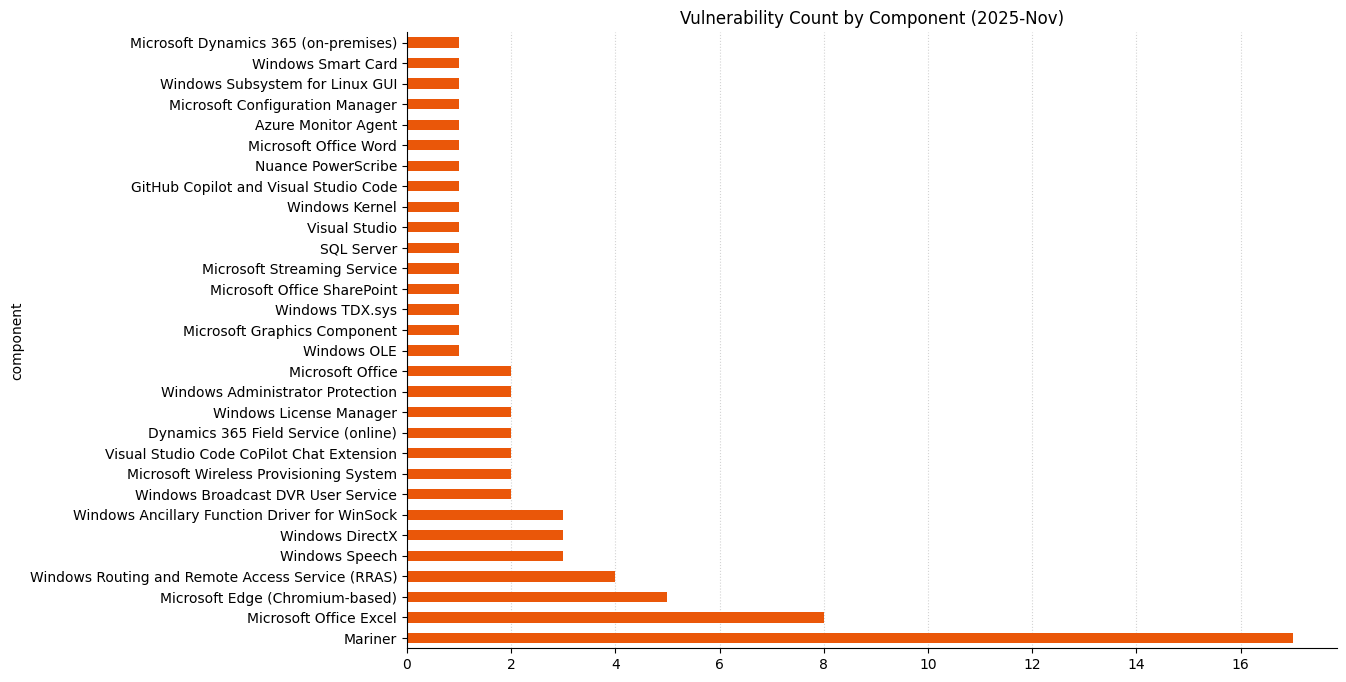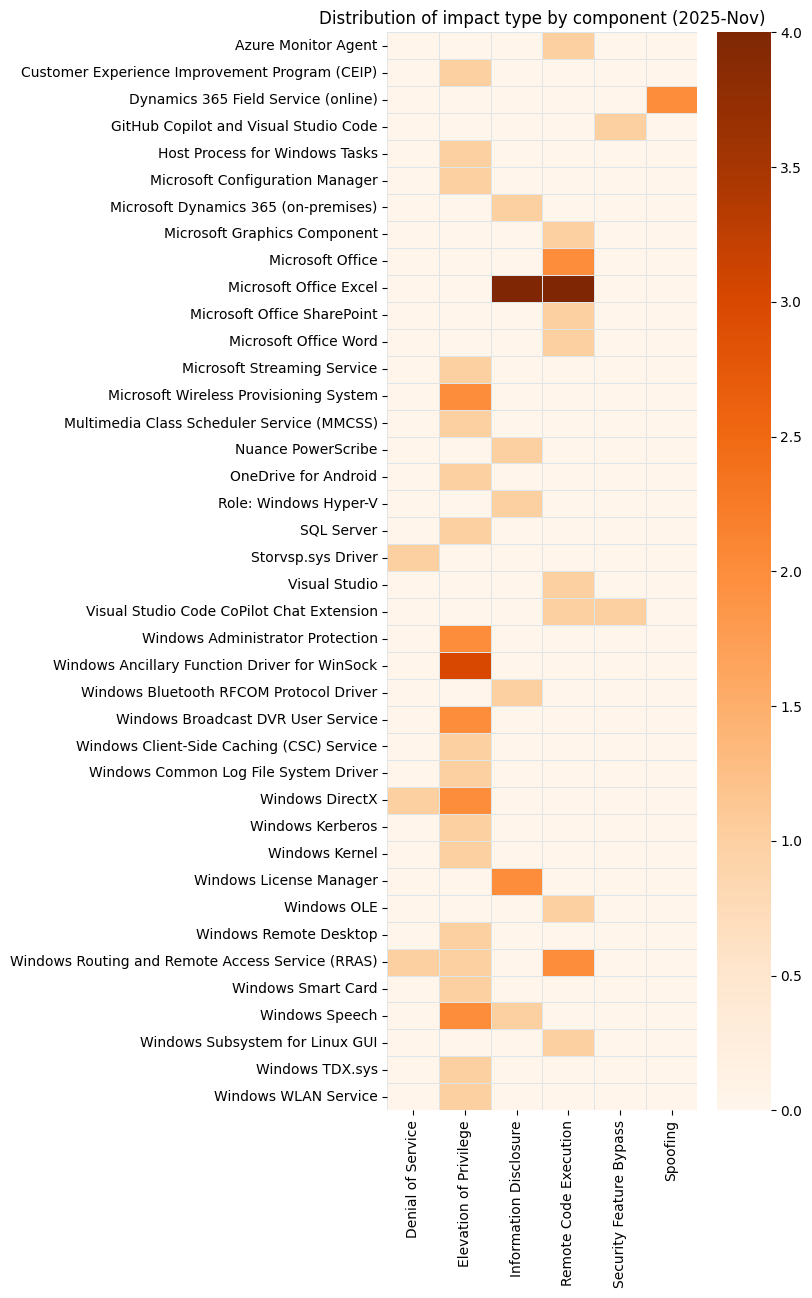Microsoft is publishing 66 new vulnerabilities today, which is far fewer than we’ve come to expect in recent months. There’s a lone exploited-in-the-wild zero-day vulnerability, which Microsoft assesses as critical severity, although there’s apparently no public disclosure yet. Three critical remote code execution (RCE) vulnerabilities are patched today; happily, Microsoft currently assesses all three as less likely to see exploitation. Five browser vulnerabilities and a dozen or so fixes for Azure Linux (aka Mariner) have already been published separately this month, and are not included in the total.
Windows GDI+: critical 0-day RCE
Faced with a fresh stack of Patch Tuesday vulns, there are a few different ways to prioritize our analysis. Do we start with vulns exploited in the wild? Pre-authentication RCEs? The vuln with the highest CVSS base score? The vuln which is likely to affect just about every asset running Microsoft software? Any of these are sensible avenues of approach, and today, all roads lead to CVE-2025-60724. As the advisory notes, in the worst-case scenario, an attacker could exploit this vulnerability by uploading a malicious document to a vulnerable web service. The advisory doesn’t spell out the context of code execution, but if all the stars align for the attacker, the prize could be remote code execution as SYSTEM via the network without any need for an existing foothold. While this vuln almost certainly isn’t wormable, it’s clearly very serious and is surely a top priority for just about anyone considering how to approach this month’s patches.
The weakness underlying CVE-2025-60724 is CWE-122: Heap-based buffer overflow, a concept which celebrated its 50th birthday several years ago. As the authors of the original 1972 paper noted: “If the code makes use of an internal buffer, there is a possibility that a user could input enough data to overwrite other portions of the program's private storage.” Regarding computer security in general, they opined that “this problem is neither hopeless nor solved. It is, however, perfectly clear [...] that solutions to the problem will not occur spontaneously, nor will they come from the various well-intentioned attempts to provide security as an add-on to existing systems.”
Office: critical ACE
Once again, we find ourselves wondering: “when is remote code execution really remote?” CVE-2025-62199 describes a critical RCE vulnerability in Microsoft Office, where exploitation relies on the user downloading and opening a malicious file. The attacker is remote, and that’s enough to satisfy the definition, even if the action is taken on the local system by the unwitting user. Anyone hoping that the Preview Pane is not a vector will be sadly disappointed, and this certainly increases the probability of real-world exploitation, since there’s no need for the attacker to craft a way around those pesky warnings about enabling dangerous content. Just scrolling through a list of emails in Outlook could be enough.
Visual Studio Copilot Extension: critical RCE
Some attacks are straightforward, with only a single step needed to reach the finish line. Others, like Visual Studio critical RCE CVE-2025-62214, require that the attacker execute a complex chain of events. In this case, exploitation demands multi-stage abuse of the Visual Studio Copilot extension, including prompt injection, Agent interaction, and triggering a build. The advisory doesn’t describe the context of code execution. If the prize is simply code execution on an asset in the context of the user, there’s no obvious advancement for the attacker, since exploitation already requires code execution on the asset by the attacker or the targeted user. The brief description of the attack chain does mention that the attacker would need to trigger a build. On that basis, possible outcomes might include execution in an elevated context, or compromised build artifacts, although the advisory does not provide enough information to be certain either way.
SQL Server: critical EoP
SQL Server admins should take note of CVE-2025-59499, which describes an elevation of privilege (EoP) vulnerability. Although some level existing privileges are required, successful exploitation will permit an attacker to run arbitrary Transact-SQL (T-SQL) commands. T-SQL is the language which SQL Server databases and clients use to communicate with one another. Although the default configuration for SQL Server disables the xp_cmdshell functionality which allows direct callouts to the underlying OS, there’s more than one way to shine a penny, and the only safe assumption here is that exploitation will lead to code execution in the context of SQL Server itself. Patches are available for all supported versions of SQL Server.
Microsoft lifecycle update
Following the sweeping lifecycle changes seen in October 2025, Microsoft is taking it fairly easy this month. The only significant transition today is the end of support for Windows 11 Home and Pro 23H2. Unlike the demise of Windows 10, this much smaller change won’t affect most people; a small number of older CPUs might not make the cut, since Windows 11 24H2 introduces a requirement for a couple of newer CPU instruction sets. Microsoft provides lists of compatible Intel, AMD, and Qualcomm CPU series.
Summary charts



Summary tables
Azure vulnerabilities
CVE
Title
Exploited?
Publicly disclosed?
CVSSv3 base score
CVE-2025-59504Azure Monitor Agent Remote Code Execution Vulnerability
No
No
7.3
Browser vulnerabilities
CVE
Title
Exploited?
Publicly disclosed?
CVSSv3 base score
CVE-2025-12729Chromium: CVE-2025-12729 Inappropriate implementation in Omnibox
No
No
N/A
CVE-2025-12728Chromium: CVE-2025-12728 Inappropriate implementation in Omnibox
No
No
N/A
CVE-2025-12727Chromium: CVE-2025-12727 Inappropriate implementation in V8
No
No
N/A
CVE-2025-12726Chromium: CVE-2025-12726 Inappropriate implementation in Views.
No
No
N/A
CVE-2025-12725Chromium: CVE-2025-12725 Out of bounds write in WebGPU
No
No
N/A
Developer Tools vulnerabilities
CVE
Title
Exploited?
Publicly disclosed?
CVSSv3 base score
CVE-2025-62222Agentic AI and Visual Studio Code Remote Code Execution Vulnerability
No
No
8.8
CVE-2025-62449Microsoft Visual Studio Code CoPilot Chat Extension Security Feature Bypass Vulnerability
No
No
6.8
CVE-2025-62214Visual Studio Remote Code Execution Vulnerability
No
No
6.7
CVE-2025-62453GitHub Copilot and Visual Studio Code Security Feature Bypass Vulnerability
No
No
5
Mariner Open Source Software vulnerabilities
CVE
Title
Exploited?
Publicly disclosed?
CVSSv3 base score
CVE-2024-25621containerd affected by a local privilege escalation via wide permissions on CRI directory
No
No
7.3
CVE-2025-10966missing SFTP host verification with wolfSSH
No
No
6.8
CVE-2025-64329containerd CRI server: Host memory exhaustion through Attach goroutine leak
No
No
N/A
Microsoft Dynamics vulnerabilities
CVE
Title
Exploited?
Publicly disclosed?
CVSSv3 base score
CVE-2025-62210Dynamics 365 Field Service (online) Spoofing Vulnerability
No
No
8.7
CVE-2025-62211Dynamics 365 Field Service (online) Spoofing Vulnerability
No
No
8.7
CVE-2025-62206Microsoft Dynamics 365 (On-Premises) Information Disclosure Vulnerability
No
No
6.5
Microsoft Office vulnerabilities
CVE
Title
Exploited?
Publicly disclosed?
CVSSv3 base score
CVE-2025-62204Microsoft SharePoint Remote Code Execution Vulnerability
No
No
8
CVE-2025-62199Microsoft Office Remote Code Execution Vulnerability
No
No
7.8
CVE-2025-62216Microsoft Office Remote Code Execution Vulnerability
No
No
7.8
CVE-2025-62205Microsoft Office Remote Code Execution Vulnerability
No
No
7.8
CVE-2025-60727Microsoft Excel Remote Code Execution Vulnerability
No
No
7.8
CVE-2025-62200Microsoft Excel Remote Code Execution Vulnerability
No
No
7.8
CVE-2025-62201Microsoft Excel Remote Code Execution Vulnerability
No
No
7.8
CVE-2025-62203Microsoft Excel Remote Code Execution Vulnerability
No
No
7.8
CVE-2025-60726Microsoft Excel Information Disclosure Vulnerability
No
No
7.1
CVE-2025-62202Microsoft Excel Information Disclosure Vulnerability
No
No
7.1
CVE-2025-60722Microsoft OneDrive for Android Elevation of Privilege Vulnerability
No
No
6.5
CVE-2025-59240Microsoft Excel Information Disclosure Vulnerability
No
No
5.5
CVE-2025-60728Microsoft Excel Information Disclosure Vulnerability
No
No
4.3
Open Source Software vulnerabilities
CVE
Title
Exploited?
Publicly disclosed?
CVSSv3 base score
CVE-2025-62220Windows Subsystem for Linux GUI Remote Code Execution Vulnerability
No
No
8.8
CVE-2025-12863Libxml2: namespace use-after-free in xmlsettreedoc() function of libxml2
No
No
7.5
CVE-2025-64433KubeVirt Arbitrary Container File Read
No
No
6.5
CVE-2025-40107can: hi311x: fix null pointer dereference when resuming from sleep before interface was enabled
No
No
5.5
CVE-2025-60753An issue was discovered in libarchive bsdtar before version 3.8.1 in function apply_substitution in file tar/subst.c when processing crafted -s substitution rules. This can cause unbounded memory allocation and lead to denial of service (Out-of-Memory crash).
No
No
5.5
CVE-2025-12875mruby array.c ary_fill_exec out-of-bounds write
No
No
5.3
CVE-2025-64435KubeVirt VMI Denial-of-Service (DoS) Using Pod Impersonation
No
No
5.3
CVE-2025-64437KubeVirt Isolation Detection Flaw Allows Arbitrary File Permission Changes
No
No
5
CVE-2025-64434KubeVirt Improper TLS Certificate Management Handling Allows API Identity Spoofing
No
No
4.7
CVE-2025-64432KubeVirt Affected by an Authentication Bypass in Kubernetes Aggregation Layer
No
No
4.7
CVE-2025-40109crypto: rng - Ensure set_ent is always present
No
No
4.2
CVE-2025-52881runc: LSM labels can be bypassed with malicious config using dummy procfs files
No
No
N/A
CVE-2025-31133runc container escape via "masked path" abuse due to mount race conditions
No
No
N/A
CVE-2025-52565container escape due to /dev/console mount and related races
No
No
N/A
CVE-2025-64436KubeVirt Excessive Role Permissions Could Enable Unauthorized VMI Migrations Between Nodes
No
No
N/A
Other vulnerabilities
CVE
Title
Exploited?
Publicly disclosed?
CVSSv3 base score
CVE-2025-30398Nuance PowerScribe 360 Information Disclosure Vulnerability
No
No
8.1
SQL Server vulnerabilities
CVE
Title
Exploited?
Publicly disclosed?
CVSSv3 base score
CVE-2025-59499Microsoft SQL Server Elevation of Privilege Vulnerability
No
No
8.8
System Center vulnerabilities
CVE
Title
Exploited?
Publicly disclosed?
CVSSv3 base score
CVE-2025-47179Configuration Manager Elevation of Privilege Vulnerability
No
No
6.7
Windows vulnerabilities
CVE
Title
Exploited?
Publicly disclosed?
CVSSv3 base score
CVE-2025-59511Windows WLAN Service Elevation of Privilege Vulnerability
No
No
7.8
CVE-2025-60713Windows Routing and Remote Access Service (RRAS) Elevation of Privilege Vulnerability
No
No
7.8
CVE-2025-60718Windows Administrator Protection Elevation of Privilege Vulnerability
No
No
7.8
CVE-2025-60721Windows Administrator Protection Elevation of Privilege Vulnerability
No
No
7.8
CVE-2025-60707Multimedia Class Scheduler Service (MMCSS) Driver Elevation of Privilege Vulnerability
No
No
7.8
CVE-2025-60710Host Process for Windows Tasks Elevation of Privilege Vulnerability
No
No
7.8
CVE-2025-59507Windows Speech Runtime Elevation of Privilege Vulnerability
No
No
7
CVE-2025-59508Windows Speech Recognition Elevation of Privilege Vulnerability
No
No
7
CVE-2025-62215Windows Kernel Elevation of Privilege Vulnerability
Yes
No
7
CVE-2025-59515Windows Broadcast DVR User Service Elevation of Privilege Vulnerability
No
No
7
CVE-2025-60717Windows Broadcast DVR User Service Elevation of Privilege Vulnerability
No
No
7
CVE-2025-62218Microsoft Wireless Provisioning System Elevation of Privilege Vulnerability
No
No
7
CVE-2025-62219Microsoft Wireless Provisioning System Elevation of Privilege Vulnerability
No
No
7
CVE-2025-60716DirectX Graphics Kernel Elevation of Privilege Vulnerability
No
No
7
CVE-2025-60708Storvsp.sys Driver Denial of Service Vulnerability
No
No
6.5
CVE-2025-60723DirectX Graphics Kernel Denial of Service Vulnerability
No
No
6.3
CVE-2025-59509Windows Speech Recognition Information Disclosure Vulnerability
No
No
5.5
CVE-2025-62208Windows License Manager Information Disclosure Vulnerability
No
No
5.5
CVE-2025-62209Windows License Manager Information Disclosure Vulnerability
No
No
5.5
CVE-2025-60706Windows Hyper-V Information Disclosure Vulnerability
No
No
5.5
Windows ESU vulnerabilities
CVE
Title
Exploited?
Publicly disclosed?
CVSSv3 base score
CVE-2025-62452Windows Routing and Remote Access Service (RRAS) Remote Code Execution Vulnerability
No
No
8
CVE-2025-60715Windows Routing and Remote Access Service (RRAS) Remote Code Execution Vulnerability
No
No
8
CVE-2025-60720Windows Transport Driver Interface (TDI) Translation Driver Elevation of Privilege Vulnerability
No
No
7.8
CVE-2025-59505Windows Smart Card Reader Elevation of Privilege Vulnerability
No
No
7.8
CVE-2025-60703Windows Remote Desktop Services Elevation of Privilege Vulnerability
No
No
7.8
CVE-2025-60714Windows OLE Remote Code Execution Vulnerability
No
No
7.8
CVE-2025-60709Windows Common Log File System Driver Elevation of Privilege Vulnerability
No
No
7.8
CVE-2025-60705Windows Client-Side Caching Elevation of Privilege Vulnerability
No
No
7.8
CVE-2025-59514Microsoft Streaming Service Proxy Elevation of Privilege Vulnerability
No
No
7.8
CVE-2025-59512Customer Experience Improvement Program (CEIP) Elevation of Privilege Vulnerability
No
No
7.8
CVE-2025-60704Windows Kerberos Elevation of Privilege Vulnerability
No
No
7.5
CVE-2025-60719Windows Ancillary Function Driver for WinSock Elevation of Privilege Vulnerability
No
No
7
CVE-2025-62217Windows Ancillary Function Driver for WinSock Elevation of Privilege Vulnerability
No
No
7
CVE-2025-62213Windows Ancillary Function Driver for WinSock Elevation of Privilege Vulnerability
No
No
7
CVE-2025-59506DirectX Graphics Kernel Elevation of Privilege Vulnerability
No
No
7
CVE-2025-59510Windows Routing and Remote Access Service (RRAS) Denial of Service Vulnerability
No
No
5.5
CVE-2025-59513Windows Bluetooth RFCOM Protocol Driver Information Disclosure Vulnerability
No
No
5.5
Windows Microsoft Office ESU vulnerabilities
CVE
Title
Exploited?
Publicly disclosed?
CVSSv3 base score
CVE-2025-60724GDI+ Remote Code Execution Vulnerability
No
No
9.8
- Patch Tuesday
- Vulnerability Management